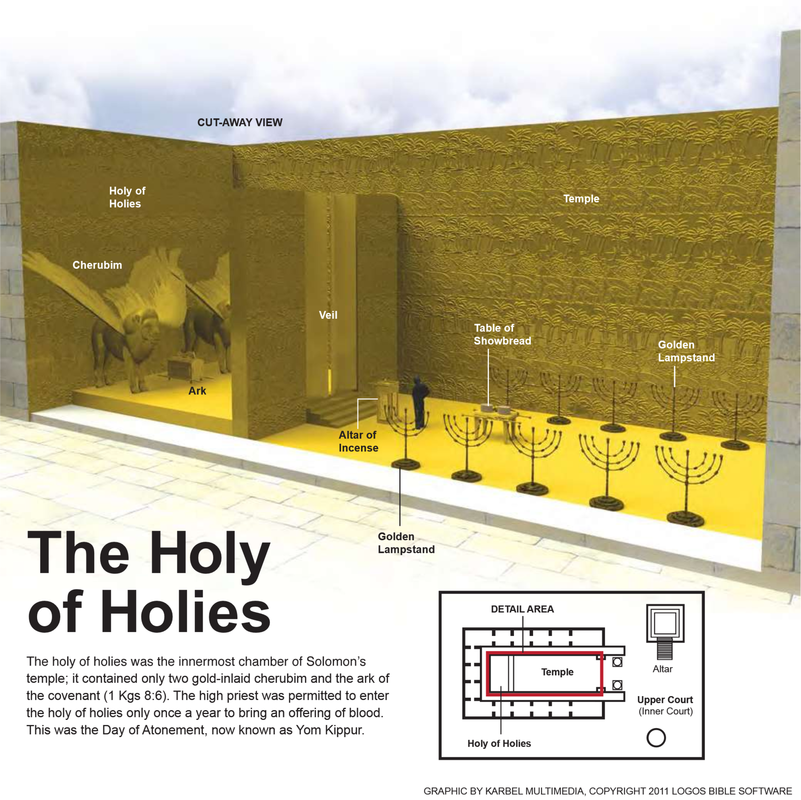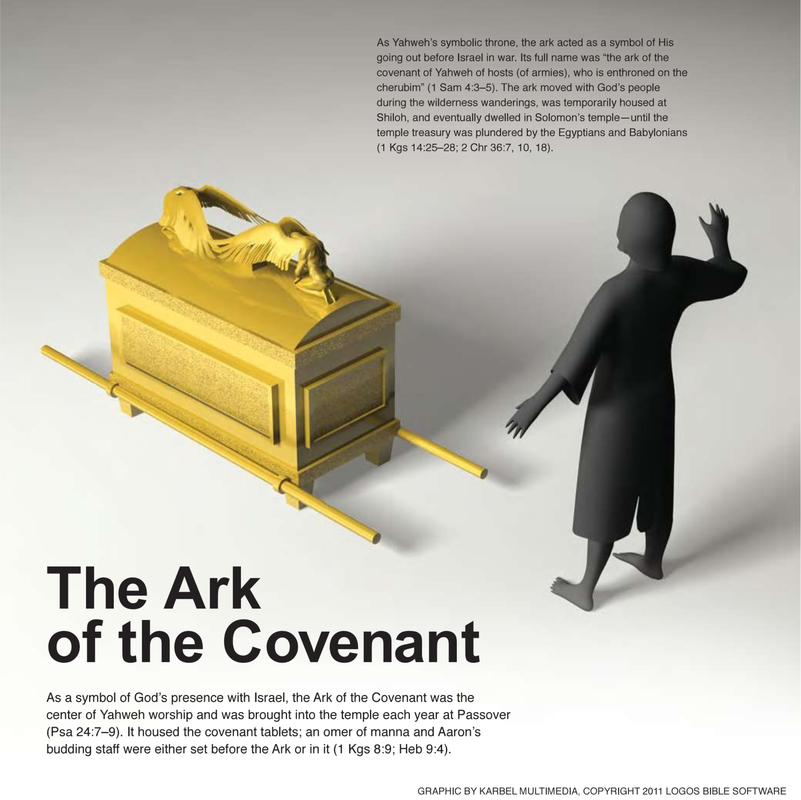Click here to read today's passage on Bible Gateway.
OT Terms
Today's passage refers to a lot of OT things. As we haven't yet done "OT in a Year", here's some help in understanding what the writer of Hebrews is talking about:
OT Terms
Today's passage refers to a lot of OT things. As we haven't yet done "OT in a Year", here's some help in understanding what the writer of Hebrews is talking about:
9:2 lampstand Located at the south side of the holy place (Exod 26:35), the lampstand was crafted of hammered gold (Exod 25:31). It included three branches on each side that resembled almond blossoms (Exod 25:33). God commanded Aaron and his sons to burn oil in this lamp perpetually (Exod 27:20–21; Lev 24:2–3).
table Stood at the north side of the holy place (Exod 26:35). The table was made of acacia wood and overlaid with gold (Exod 25:23–24). It held various religious objects, including dishes for incense and bowls for drink offerings (Exod 25:29–30).
presentation of the loaves These loaves were arranged in two rows and placed upon the table each Sabbath (Exod 40:23; Lev 24:6, 29; 1 Chr 9:32).
9:3 second curtain The deuteron katapetasma partitioned the holy place from the most holy place (Exod 26:31–35), separating the place of regular priestly ministry from the holy of holies.
holy of holies The Hagia Hagiōn was the place of God’s presence. It contained an incense altar and the ark of the covenant (see vv. 4; Exod 25:10; 26:33; 40:3). The expression is superlative, indicating that the inner sanctuary is the most holy place.
9:4 golden incense altar According to Hebrews, the thymiatērion was located in the most holy place (the holy of holies) of the tabernacle or the temple. On the Day of Atonement, priests sprinkled blood from the sin offering upon the horns of the incense altar and upon the mercy seat (Exod 30:10; Lev 16:15; compare Isa 52:15 and note).
table Stood at the north side of the holy place (Exod 26:35). The table was made of acacia wood and overlaid with gold (Exod 25:23–24). It held various religious objects, including dishes for incense and bowls for drink offerings (Exod 25:29–30).
presentation of the loaves These loaves were arranged in two rows and placed upon the table each Sabbath (Exod 40:23; Lev 24:6, 29; 1 Chr 9:32).
9:3 second curtain The deuteron katapetasma partitioned the holy place from the most holy place (Exod 26:31–35), separating the place of regular priestly ministry from the holy of holies.
holy of holies The Hagia Hagiōn was the place of God’s presence. It contained an incense altar and the ark of the covenant (see vv. 4; Exod 25:10; 26:33; 40:3). The expression is superlative, indicating that the inner sanctuary is the most holy place.
9:4 golden incense altar According to Hebrews, the thymiatērion was located in the most holy place (the holy of holies) of the tabernacle or the temple. On the Day of Atonement, priests sprinkled blood from the sin offering upon the horns of the incense altar and upon the mercy seat (Exod 30:10; Lev 16:15; compare Isa 52:15 and note).
ark of the covenant Located in the most holy place, the ark was made of acacia wood and overlaid with gold (Exod 25:10–15; 37:1–5). The Israelites carried the ark using two long poles so that no one would touch the ark itself and die. The ark mediated God’s presence to the people (Exod 25:22).
golden jar Moses instructed Aaron to collect some manna—the bread God gave the Israelites from heaven—and place it in a jar “before the LORD” (Exod 16:33–34 ESV). Only the Septuagint includes the detail that the jar was “golden” (chrysē).
rod of Aaron Refers to Aaron’s staff that miraculously blossomed, demonstrating that God called Aaron and his sons to the ministry of the priesthood (Num 17:1–11).
tablets Moses received the stone tablets (Deut 9:9) with God’s law written on them (Deut 9:10). The Israelites placed these tablets within the ark (Deut 10:1–5).
9:5 cherubim of glory Refers to two winged, angelic creatures (see Gen 3:24; Ezek 10:20) made of gold (Exod 25:18–22). The cherubim overshadowed the mercy seat from either side of the ark. God was enthroned between the two cherubim (1 Sam 4:4; 2 Sam 6:2; Isa 37:16). Therefore, “glory” (doxēs) refers to the glorious presence of God when He dwells among His people.
mercy seat The term to hilastērion refers to the golden lid of the ark. This lid was considered the earthly counterpart to the throne of grace (see 4:16). On the Day of Atonement, God appeared in a cloud over the mercy seat (Lev 16:13–17). Moses (and later the priesthood) met with God there (Exod 25:22; Num 7:89)." [1]
Hope that helps in getting a picture of what he's talking about here! As I said, the audience of this book was primarily Jewish, so sometimes we don't get these references as well as we could.
Questions? Comments?
golden jar Moses instructed Aaron to collect some manna—the bread God gave the Israelites from heaven—and place it in a jar “before the LORD” (Exod 16:33–34 ESV). Only the Septuagint includes the detail that the jar was “golden” (chrysē).
rod of Aaron Refers to Aaron’s staff that miraculously blossomed, demonstrating that God called Aaron and his sons to the ministry of the priesthood (Num 17:1–11).
tablets Moses received the stone tablets (Deut 9:9) with God’s law written on them (Deut 9:10). The Israelites placed these tablets within the ark (Deut 10:1–5).
9:5 cherubim of glory Refers to two winged, angelic creatures (see Gen 3:24; Ezek 10:20) made of gold (Exod 25:18–22). The cherubim overshadowed the mercy seat from either side of the ark. God was enthroned between the two cherubim (1 Sam 4:4; 2 Sam 6:2; Isa 37:16). Therefore, “glory” (doxēs) refers to the glorious presence of God when He dwells among His people.
mercy seat The term to hilastērion refers to the golden lid of the ark. This lid was considered the earthly counterpart to the throne of grace (see 4:16). On the Day of Atonement, God appeared in a cloud over the mercy seat (Lev 16:13–17). Moses (and later the priesthood) met with God there (Exod 25:22; Num 7:89)." [1]
Hope that helps in getting a picture of what he's talking about here! As I said, the audience of this book was primarily Jewish, so sometimes we don't get these references as well as we could.
Questions? Comments?
[1] John D. Barry, Michael R. Grigoni, Michael S. Heiser et al., Faithlife Study Bible (Bellingham, WA: Logos Bible Software, 2012), Heb 9:2–5.


 RSS Feed
RSS Feed
